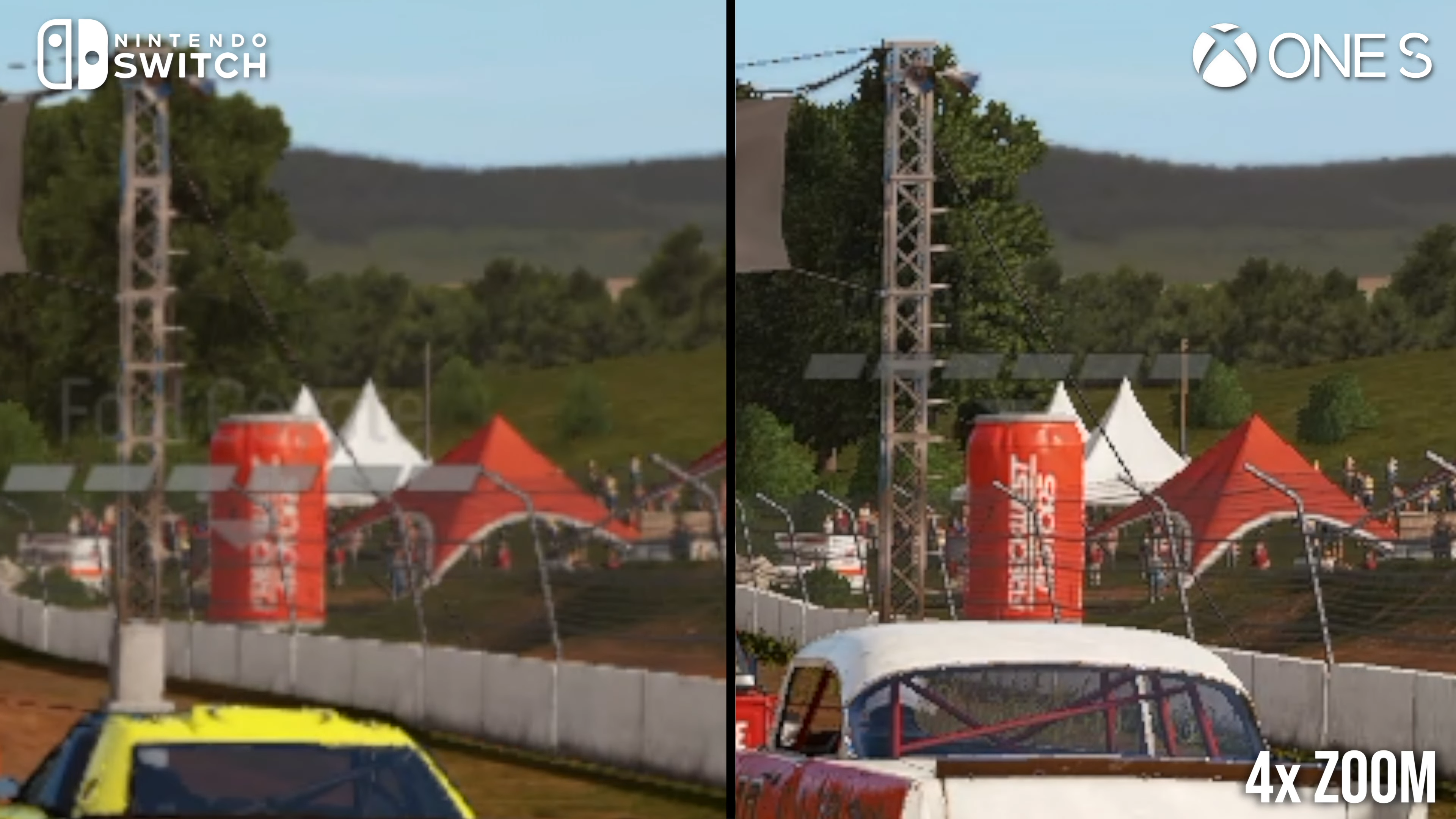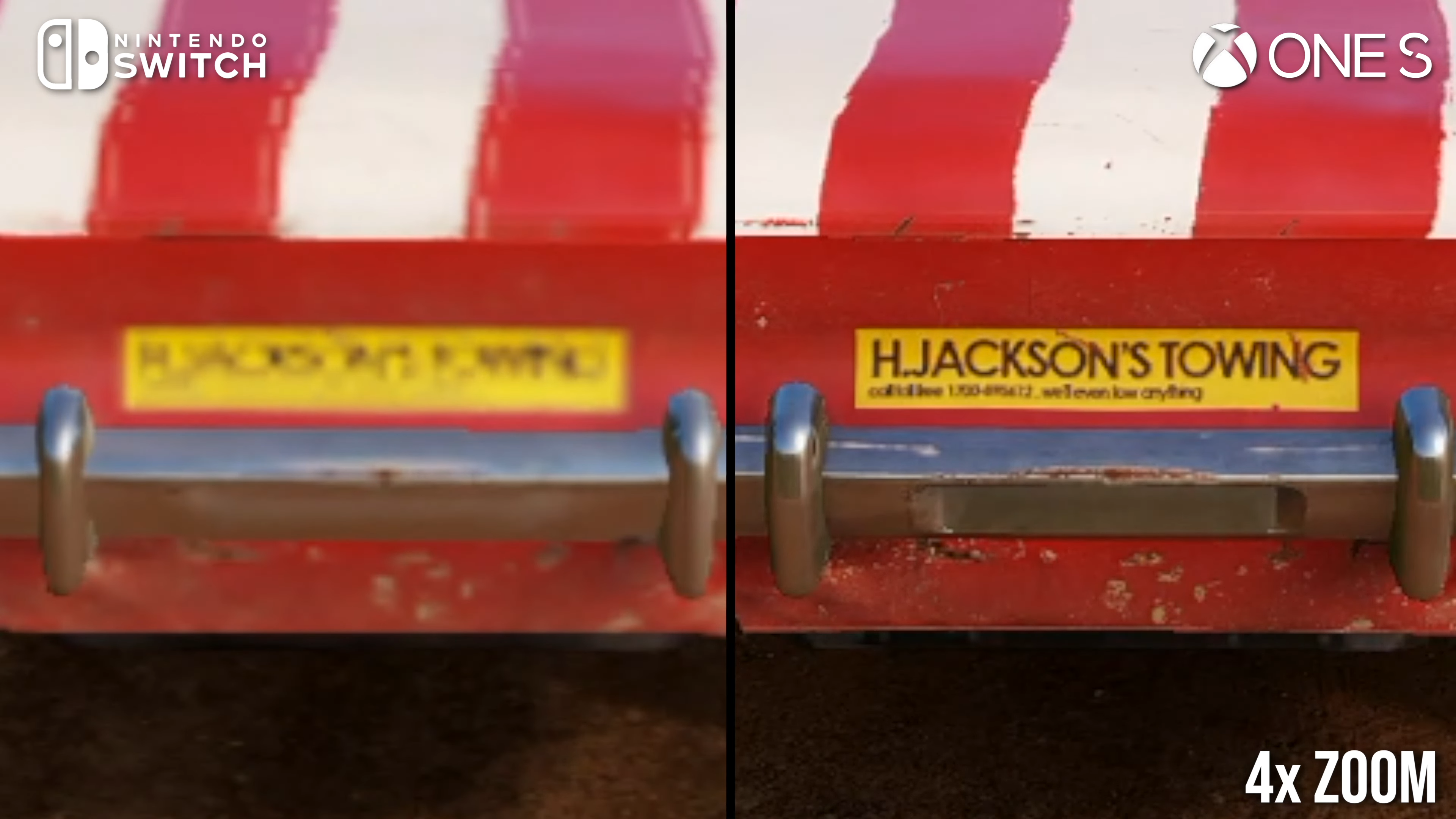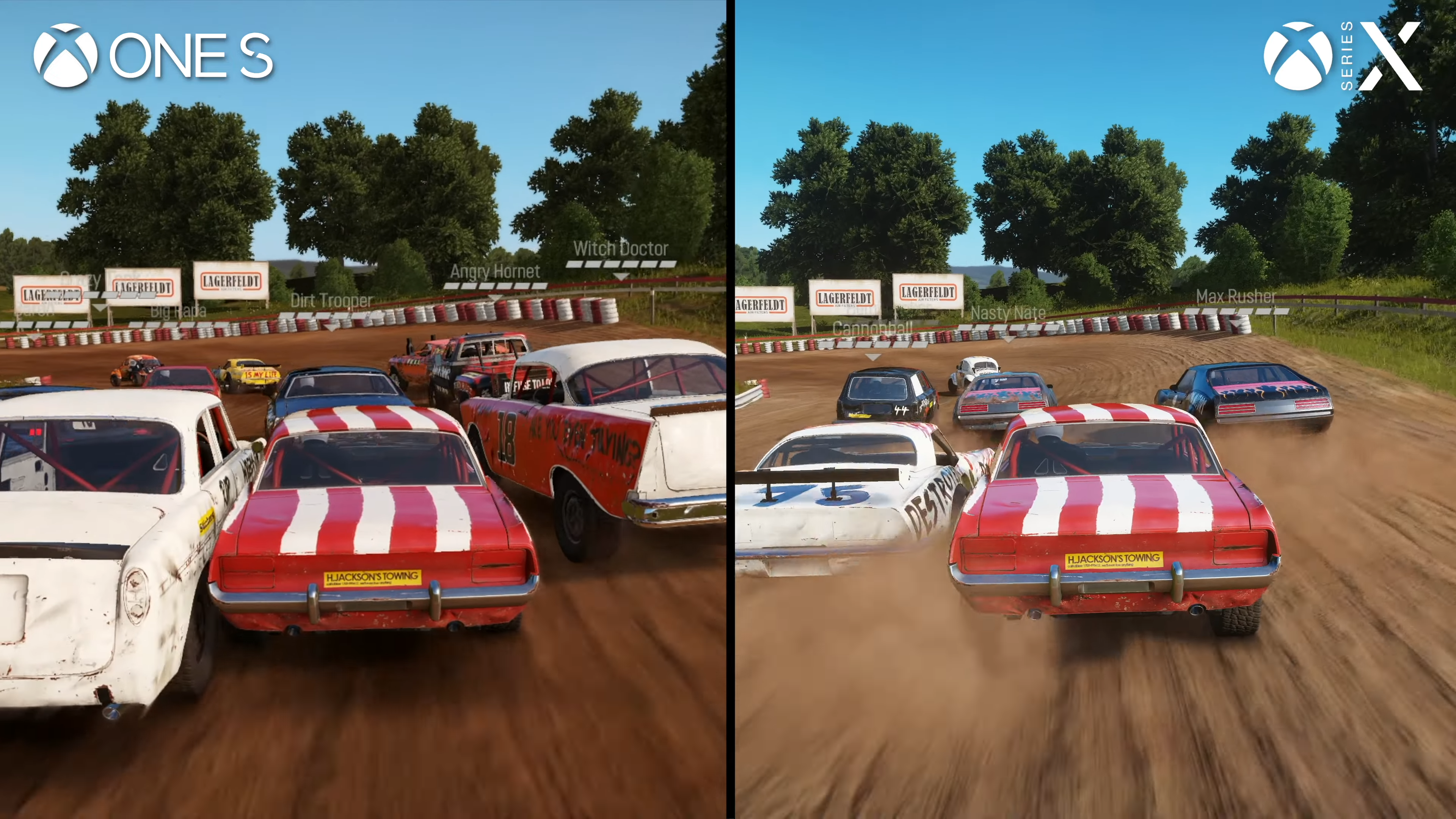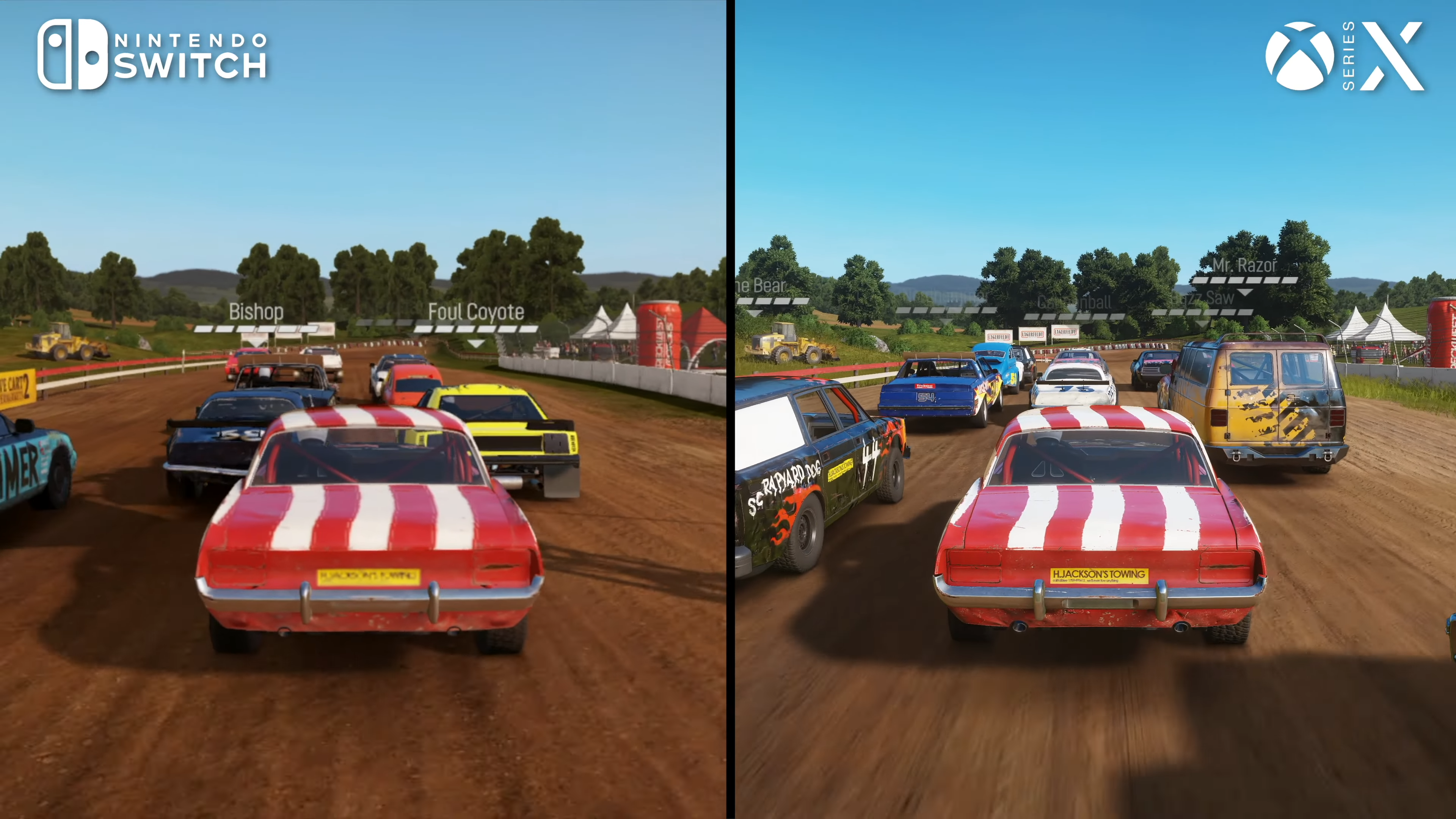Wreckfest is a racing game that you shouldn’t be afraid of. The races involve pushing, jostling and ramming, which is supported by the track design. Cars cross and push other vehicles into the track barriers. Developed by Flatout developer Bugbear Entertainment, Wreckfest marks a long-awaited return to form for demolition derby games. Having debuted on PC in 2018, it has since been ported to current and last-gen consoles. It recently became available on the Nintendo Switch as well. Today we’re taking a look at Wreckfest for all console formats, with a special focus on the Switch. How well does this game scale from Nintendo’s hybrid console to the PS5?
The appeal of Wreckfest is in the destruction. Vehicle damage is fully simulated here, with cars realistically crumple and disintegrate in collisions. In the event of a collision, fender and sheet metal parts are left behind, and parts of concrete barriers or tire walls are often blown up. The damage system is backed by a solid handling model, with vehicles that feel heavy and require finesse around corners, but also some arcade features that prevent mistakes from being overly penalized.
Technically, Wreckfest is a good-looking but not particularly ambitious title, apart from its excellent car damage model. The cars are highly detailed, there’s plenty of track geometry, and pop-ins are minimal. Bounced shots tend to look fairly flat, auto-reflections are fairly basic, and anti-aliasing is non-existent. This is a somewhat unusual feature set, perhaps explained by a smaller team starting development in 2012 with a custom engine. But here’s how it becomes a winning formula for the Switch: conservative rendering technology plus a custom, tweakable engine.

At first glance, the Switch version actually looks similar to the versions for the last-gen consoles. All major rendering technologies are intact and the 1600×900 resolution isn’t far off the 1920×1080 used on the Xbox One. It is only upon closer inspection that the differences become apparent, such as low-quality textures and simpler foliage that does not receive lighting or casts its own shadow. Some other track details have also been slightly simplified, such as: B. the crowds, while the vehicle geometry was streamlined. There also seem to have been some optimizations in the post-processing, with the motion blur being completely absent. Despite these trade-offs, Wreckfest holds up well, and to be honest the trade-offs are pretty minimal compared to other Switch implementations we’ve seen lately – such as the thematically similar WRC 10.


The performance is also quite solid. Just like the last-gen versions, 30 frames per second is the goal and it mostly achieves that. During gameplay, certain more challenging sections of track or lots of cars on screen can sometimes cause brief dips, while replays are more problematic, often dropping to 20fps for longer periods. It looks like Wreckfest uses double-buffered v-sync, so dips are very noticeable when they occur. Fortunately, frame rates are surprisingly consistent overall.
Playing in handheld mode holds a few surprises. The visual settings remain essentially the same, while the resolution drops from 1600×900 to 960×540. Curiously, the Switch’s 720p screen is upscaled in resolution, using Nearest Neighbor Filtering, which preserves edge clarity by unevenly scaling the image to fit the output resolution’s pixel grid. An approach we’ve already seen in games like Astral Chain and the Assassin’s Creed Ezio Collection. Unfortunately, without any form of linear filtering, the image looks blockier than it needs to be, drawing even more attention to the aliasing issues. Portable mode is generally good and performance seems about on par with the game in the dock, but I wish they’d used bilinear filtering instead.

Overall, however, it is a skilful implementation. Wreckfest runs on the Switch with small trade-offs, not massive trade-offs. Wreckfest’s visuals remain largely intact and the game looks appealing, so the Switch release is a success. Now let’s take a look at the versions for last-gen consoles.
The Xbox One version is representative of the last-gen console releases in terms of basic visual settings. Texture quality, models and post-processing are the same as the Xbox One version on the other three last-gen devices, with vehicle and grass shadows improved on PS4 Pro and Xbox One X. PS4 and Xbox One run at 1080p without AA, as does the One X by default (and the PS4 Pro with a resolution fixed at 1080p), but the Pro consoles also offer higher resolution modes. The One X has a simple 4K toggle that offers significantly improved image sharpness, although flicker is still an issue. The PS4 Pro instead uses checkerboard rendering at 1800p when set to 4K, but that oddly creates some issues. The image is riddled with artifacts and jumps from frame to frame. Very few edges resolve to a clean 1800p and image reconstruction is basically non-functional; I prefer the 1080p rendering here. Frame rates are quite good on the last-gen consoles, however, with the One X, PS4 and PS4 Pro all delivering essentially a constant 30fps. The Xbox One is the oddball, occasionally dropping frames and showing tearing, but mostly hitting the 30fps target.

After the release of last-gen console versions in 2019, Wreckfest has been fully optimized for current-gen platforms in 2021, and surprisingly, the most obvious change is color grading. The game looks colder overall – less sepia, more blue – with more vibrancy and contrast. I like the new look and thought it might be a technical upgrade, but on closer inspection it actually seems more like a stylistic change to match the PC version. Some minor details have also been improved. Grass and bushes are further removed and rendered with higher density, Alpha effects have more volume, and Dirt effects have geometric dirt particles, a nice touch. There’s also bloom lighting, which is most visible on bright stretches above the horizon, while shafts of light pierce through the trees when the sun is low. Finally, shadow draw distance has been significantly increased, helping to ground distant vehicles.
The PS5 and Series X offer full 4K resolution on top of these improvements, while the Series S stays at 1080p, but just like the last-gen devices, there’s no AA, so artefacts remain noticeable. Thankfully frame rates are doubled to 60fps and performance is great, especially the PS5 stayed at 60fps even in scenes that caused dips on other platforms. The Series S has seen dips more often, particularly in replays, and the Series X is currently the worst of the three consoles with repeated frame-rate dips and tearing in hectic moments. Replays suffer as well, with longer chunks in the 50-60fps range. This isn’t a disaster, 60fps is possible most of the time throughout the game, but those moments do pop up a couple of times per race.

So the code for Wreckfest’s current-gen consoles offers a major improvement – 60 frames per second – as well as incremental but welcome settings improvements to improve visual quality. However, performance drops are a problem on Microsoft’s consoles and perhaps the features on the Series X should be scaled back a bit given the performance fluctuations.
After completing our analysis, we can say that Wreckfest is worth playing on any system, but the Switch port really shines. It’s a full-fledged conversion of the last-gen console version, with just a few notable tweaks. None of the rendering fundamentals have been lost in the port, and the compromises required to run the game on portable hardware are hard to tell at first glance. Given the compromises other Switch implementations have been making lately, that’s a welcome outlier.

Even on the current-gen consoles, the game offers a solid level of scalability. While the visual improvements are incremental rather than fundamental, Wreckfest gets a nice boost on the new devices while the last-gen consoles continue to perform well. The only issue worth noting is the bizarre checkerboard implementation on the PS4 Pro, which could use a little more attention.
Of course, more important than the technical details is the fact that Wreckfest is a very good racing game. And the only decent demolition derby-style racing game in years. It’s a worthy successor to games like Flatout and Test Drive: Eve of Destruction. The cars are easy to drive, the races are dynamic and, most importantly, the destruction is extremely well executed. Few other modern games can offer the same catastrophic thrill.
Originally by Oliver Mackenzie, Freelance Editor, Eurogamer.net
The post Wreckfest on the Switch impressed us, even when compared to the PS5 and Series X appeared first on Gamingsym.
